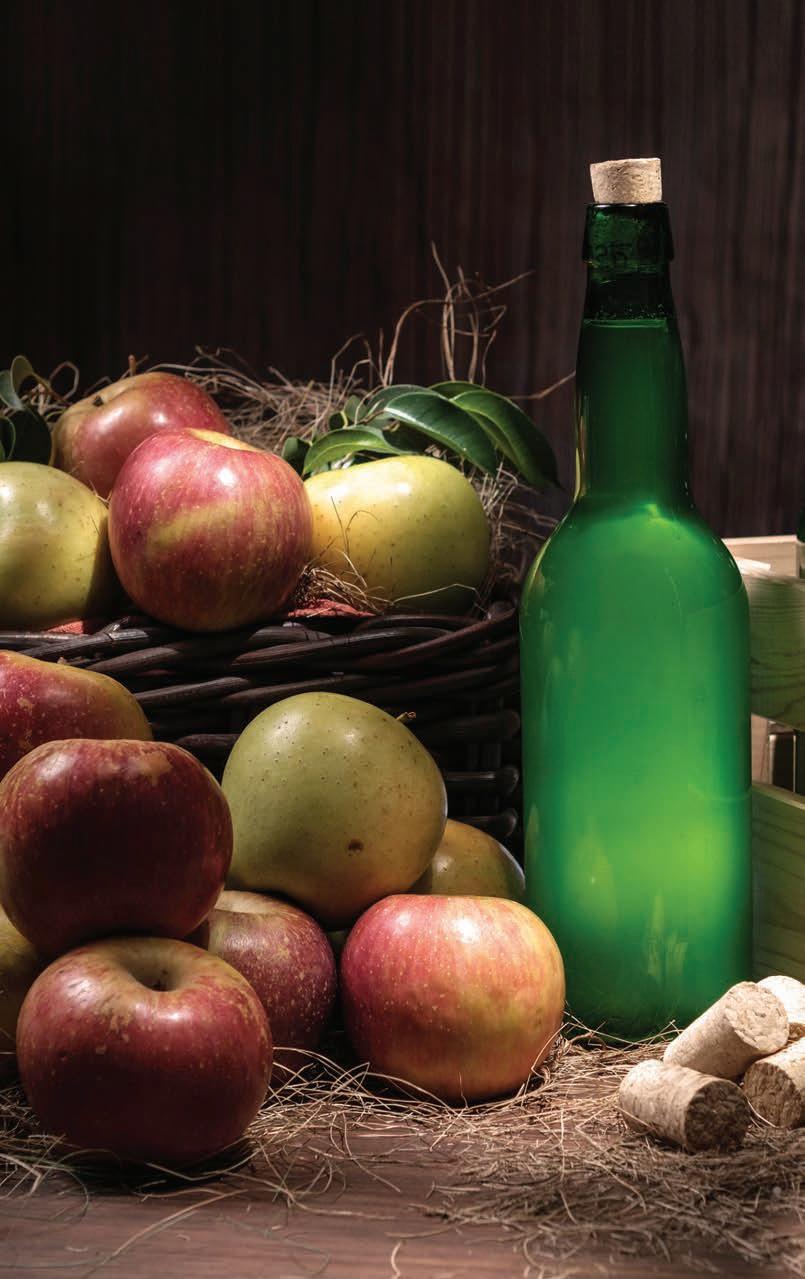
14 minute read
FROM MEXICO — It’s Sidra Season
| BY JOSEPH SORRENTINO, writing from Mexico | The smell of apples drifts out of Sidra San Francisco’s front door, enticing passersby to enter. If they do, they’ll discover a small store where Gabriel Hernandez Garcia makes sidra (hard cider), the fourth generation in his family to do so. Garcia makes his sidra in Huejotzingo, Puebla, the same city where his great-grandfather became the first person in Mexico to learn how to make it almost one hundred years ago.
Sidra has a very long history. There’s evidence that Celts in Britain were making it as long ago as 3,000 BC. Romans discovered sidra when Julius Caesar made his first attempt to conquer Britain in 55 BC. Caesar and his army apparently liked it so much that they brought it back with them to the continent and made the first written record of the drink. Sidra, and sidra-making techniques, quickly spread throughout the Roman Empire and Europe. In 1927, it started taking root in Mexico.
It was during that year that Gabriel Guerrero Miruela, Garcia’s great-grandfather, learned how to make sidra from a French chef who lived in Huejotzingo. “My great-grandfather taught his sons,” says Garcia, “and my grandmother taught me. When I was young, my grandmother transmitted this love of sidra to me.” He worked by her side for four years to fully learn the process.
– GABRIEL HERNANDEZ GARCIA, Sidra San Francisco
It’s Sidra SEASON
Cider Stars in Legendary Santa Fe Cocktail
When a cocktail is so renowned that it not only makes it into local press but also into the annals of Wikipedia, you know it’s something special.
That’s just the story of the Chimayo Cocktail, created in 1965 by Arturo Jaramillo, then owner of Rancho de Chimayó restaurant in Chimayo, New Mexico. The state is one of the oldest apple-growing regions in the country.
“Legend has it that Jaramillo was looking for use for the apples that are plentiful in the Chimayó valley when he stumbled onto what would soon become the signature drink of his restaurant,” the Wikipedia listing explains. Find the recipe on page 55.
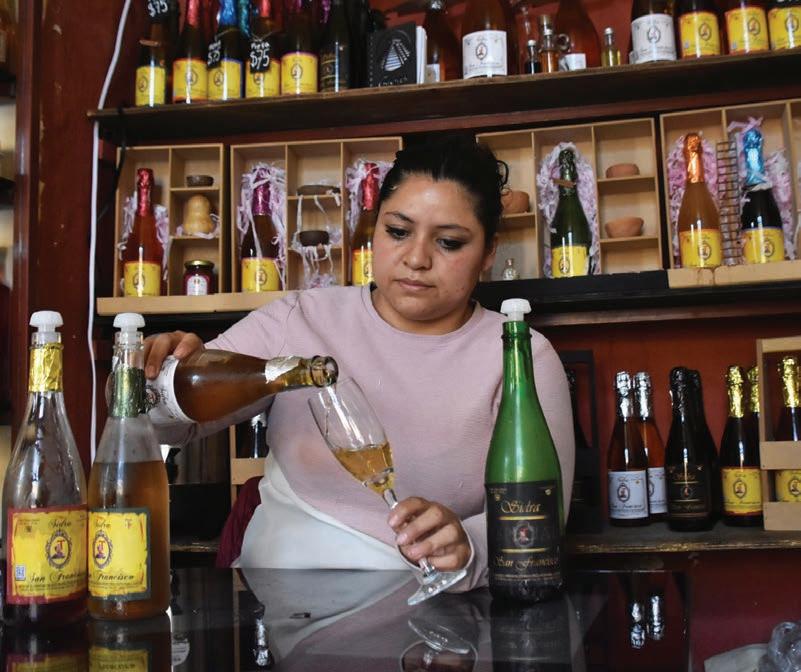
A BOOMING BUSINESS IN HUEJOTZINGO
Huejotzingo has become famous for its sidra, and there are now around 30 businesses producing it.
“Seventy percent of the fabricas making sidra in Huejotzingo are family,” Garcia says. The beverage is served at many special occasions, including quincieñeras and weddings. It’s especially popular at Christmas and New Year.
Garcia makes his sidra in a tiny room at the back of his store.
“We make sidra from April through November,” says Andrea Martinez Castillo, Garcia’s wife, who also works in the store. They only use one kind of apple — perón — which are grown in the pueblos surrounding Popocatépetl, an active volcano in Puebla. “We use these apples because they have a good level of acid and they are flavorful,” she says.
There aren’t many apples available in early spring and she figures they only use about 200 pounds a month from April through June. In July and August, production increases dramatically and they’ll use four tons a month. Their sidra is artesanal: it’s all produced by hand.
Garcia dips a small basket into the water where the apples are washing and then pours them into a grinder. The pulp is exuded onto wooden trays that are covered with a cloth. “The wood is from old apple trees or from branches that have broken,” explains Castillo. Each tray holds about 20 pounds of pulp, which Garcia gently, almost lovingly, pats down until it’s evenly spread. Once filled, the pulp is covered with a cloth and the trays are swung into position where pressure is applied. The resulting juice is collected in a plastic barrel. “In one day, in eight hours, I will grind one ton of apples,” Garcia says.
The juice is placed in 200-liter oak barrels — oak will impart to the sidra its special flavor and color — where it’s left to ferment for three months. Sidra is typically 3.5% alcohol. “The apple seeds contain yeast, and this is what drives the fermentation,” Garcia explains. “When the apples are crushed, the seeds release the yeast that’s contained in its shell. We do not add yeast. We do not stop the fermentation. When the yeast has used up all the sugars in the juice, the yeast dies and precipitates.”
Andrea Castillo serving freshly bottled sidra
– GABRIEL HERNANDEZ GARCIA, Sidra San Francisco
The fermented juice is transferred to other oak barrels, which are filled to the top, covered and sealed with parafin.
“All juice is aged for three years in the barrels,” says Castillo. “We give it this time to so that it reaches the notes and flavors that characterize [our] sidra. When the juice matures in oak barrels for three years, it acquires a better quality, body and flavor.” Those barrels are stored in a separate building. “We control the light, temperature, humidity,” says Garcia. “These barrels are in another place where they cannot be disturbed.”
After three years, the sidra is bottled. Garcia says he can bottle 1,600 a day, about 96,000 a year.
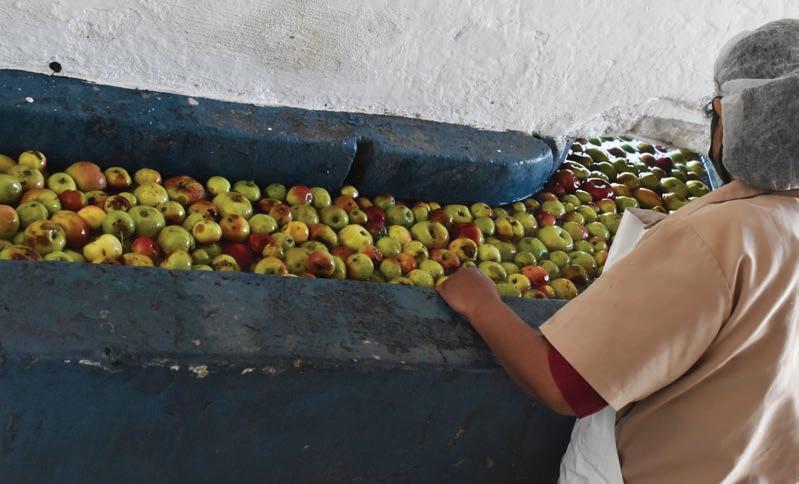
A VISIT TO COPA DE ORO
Forty miles from Huejotzingo, Copa de Oro, in San Pedro Cholula, has been turning apples into sidra since 1936. The business was started by Ramón Blanca Amador and it’s still family-owned. Copa de Oro now occupies almost an entire city block and production has been scaled up to an industrial level.
The first trucks laden with apples arrive in late June.
“We use three types of apples for our sidra,” says Alejandra Toxqui Carranza, who’s in charge of corporate sales. “Perón, panochera and ripio.” These apples also come from the pueblos surrounding Popocatépetl.
Every day for several weeks, a stream of water propels one ton of apples down a concrete conduit to a grinder after which, like at Sidra San Francisco, the pulp is pressed. Only here, the pulp is squeezed by a huge hydraulic press.
“The liquid is squeezed out from the pulp and collected in a tank,” says Andriana Rojas, a production assistant. “From the tank, the liquid passes through another pipe to [steel] storage tanks that are kept at 4º C (39º F).”
After two or three days, the cooled juice is transferred to huge oak barrels — with a capacity between 32,000 and 70,000 liters — for the fermentation step which, here, is 10 to 15 days. At the end of this step, the juice is transferred to another set of huge oak barrels where, depending on the type of sidra, it’s aged for two to five years and then bottled. “We fill 30,000 bottles a day,” says Adriana Rojas, another production assistant.
“Each year, we produce 300,000 boxes each containing six bottles,” says Jaime Mancilla Salas, head of production. That’s 1.8 million bottles, a quantity that makes it virtually impossible for the sidra to be produced by hand.
“It was 15 to 20 years ago that we mechanized production,” says Heriberto Morales López, head of transformation.
Feeding apples into the grinder is one of the first steps in sidra production.
POPULAR VARIETIES
Both Sidra San Francisco and Copa de Oro make several types of sidra. The most popular for both is ambar, an amber-colored cider also referred to as “champagne.” It’s a sparkling drink that’s very smooth and refreshing.
Sidra San Francisco sells several sidras mixed with other fruit juices, including pear, peach and strawberry. Both companies have sidras mixed with red wine. Copa de Oro buys its wine from Chilean vineyards, but Garcia and Castillo make their own, beginning in November.
“We make our own because we have the experience,” says Castillo. “We have experimented and determined how to make the most flavorful wine.”
Copa de Oro also makes an apple beer and a non-alcoholic sidra. Garcia was taken aback when asked if he also made a non-alcoholic version.
“To be called sidra, it must be fermented apple juice,” he says. “Sidra without alcohol is not sidra.”
Joseph Sorrentino is el Restaurante’s contributing writer based in Mexico.
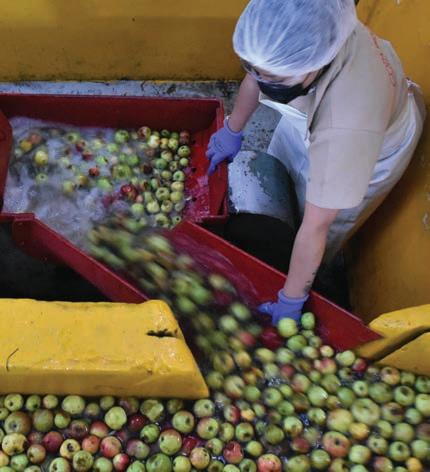
| POR JOSEPH SORRENTINO, escribiendo desde México | El aroma de las manzanas sale de la puerta principal de Sidra San Francisco, tentando a los transeúntes a entrar. Al hacerlo, descubrirán una pequeña tienda en la que Gabriel Hernández García fabrica sidra, la cuarta generación de su familia en hacerlo. García elabora su sidra en Huejotzingo, Puebla, la misma ciudad en la que su bisabuelo se convirtió en la primera persona de México en aprender a hacerla hace casi cien años. La sidra tiene una historia muy larga. Hay pruebas de que los celtas de Gran Bretaña ya la elaboraban en el año 3.000 a.C. Los romanos descubrieron la sidra cuando Julio César hizo su primer intento de conquistar Gran Bretaña en el año 55 a.C. Al parecer, a César y a su ejército les gustó tanto que se la llevaron al continente y dejaron constancia escrita de la bebida. La sidra, y las técnicas de elaboración de la misma, se extendieron rápidamente por todo el Imperio Romano y Europa. En 1927, empezó a arraigarse en México.
Fue durante ese año cuando Gabriel Guerrero Miruela, bisabuelo de García, aprendió a hacer la sidra de un chef francés que vivía en Huejotzingo. “Mi bisabuelo enseñó a sus hijos”, dice García, “y mi abuela me enseñó
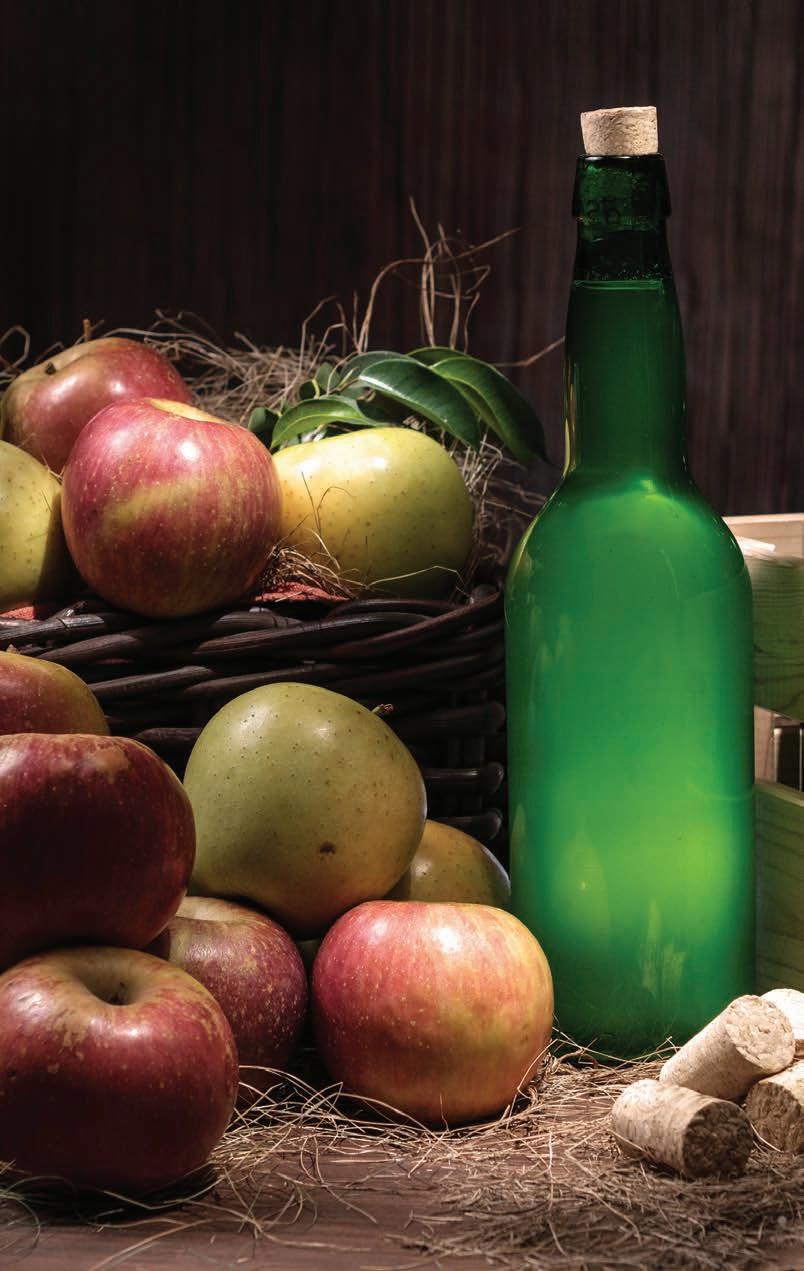
“Mi bisabuelo enseñó a sus hijos y mi abuela me enseñó a mí. Cuando era joven, mi abuela me transmitió este amor por la sidra”.
– GABRIEL HERNÁNDEZ GARCÍA, Sidra San Francisco
ES LA TEMPORADA DE LA SIDRA
La sidra protagoniza el legendario cóctel de Santa Fe
Cuando un cóctel tiene tanta fama que no sólo aparece en la prensa local, sino también en los anales de Wikipedia, sabes que es algo especial.
Esa es la historia del Cóctel Chimayo, creado en 1965 por Arturo Jaramillo, entonces propietario del restaurante Rancho de Chimayó, en Chimayo, Nuevo México. Este estado es una de las regiones productoras de manzanas más antiguas del país.
“La leyenda cuenta que Jaramillo estaba buscando un uso para las manzanas que abundan en el valle de Chimayó cuando se tropezó con lo que pronto se convertiría en la bebida distintiva de su restaurante”, explica la lista de Wikipedia.
Encuentre la receta en la página 55. a mí. Cuando era joven, mi abuela me transmitió ese amor por la sidra”. Trabajó a su lado durante cuatro años para aprender plenamente el proceso.
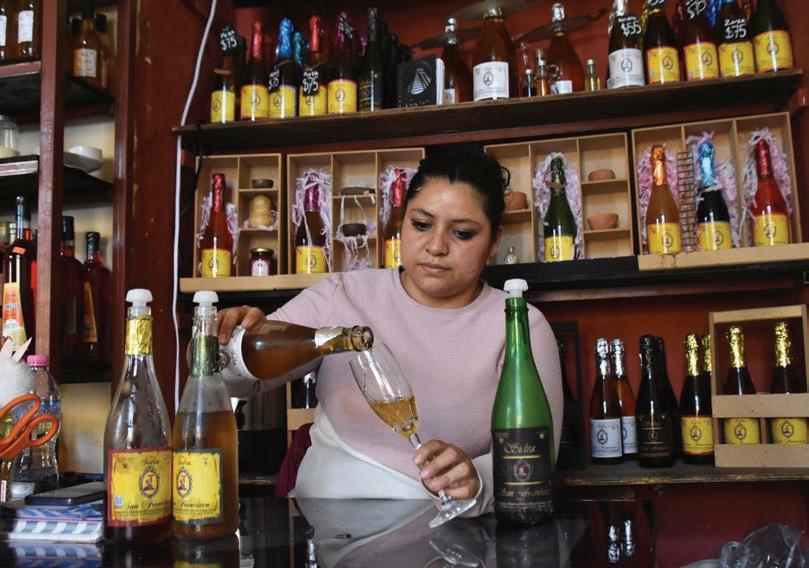
UN NEGOCIO EN AUGE EN HUEJOTZINGO
Huejotzingo se ha hecho famoso por su sidra, y ahora hay unas 30 empresas que la producen.
“El 70 % de las fábricas que hacen sidra en Huejotzingo son familiares”, dice García. La bebida se sirve en muchas ocasiones especiales, entre ellas las quinceañeras y las bodas. Es especialmente popular en Navidad y Año Nuevo.
García elabora su sidra en una pequeña habitación en la parte trasera de su tienda.
“Hacemos sidra desde abril hasta noviembre”, dice Andrea Martínez Castillo, la mujer de García, que también trabaja en la tienda. Sólo utilizan un tipo de manzana, el perón, que se cultiva en los pueblos que rodean el Popocatépetl, un volcán activo de Puebla. “Utilizamos estas manzanas porque tienen un buen nivel de acidez y son sabrosas”, dice.
No hay muchas manzanas disponibles a principios de la primavera y calcula que sólo utilizan unas 200 libras al mes de abril a junio. En julio y agosto, la producción aumenta considerablemente y utilizan cuatro toneladas al mes. Su sidra es artesanal: toda ella se produce a mano.
García sumerge una pequeña cesta en el agua donde se lavan las manzanas y luego las vierte en una trituradora. La pulpa sale en bandejas de madera que se cubren con un paño. “La madera es de manzanos viejos o de ramas que se han roto”, explica Castillo. Cada bandeja contiene unas 20 libras de pulpa, que García palmea suavemente, casi con cariño, hasta que queda uniformemente repartida.
Una vez rellenada, la pulpa se cubre con un paño y las bandejas se giran hasta su posición, donde se aplica presión. El zumo resultante se recoge en un barril de plástico. “En un día, en ocho horas, trituraré una tonelada de manzanas”, dice García.
El zumo se coloca en barricas de roble de 200 litros, el roble dará a la sidra su sabor y color especiales, donde se deja fermentar durante tres meses. La sidra suele tener un 3,5 % de alcohol. “Las semillas de las manzanas contienen levadura, que es la que impulsa la fermentación”, explica García. “Cuando se trituran las manzanas, las semillas liberan la levadura que contiene su
Andrea Castillo sirviendo sidra recién embotellada
– GABRIEL HERNÁNDEZ GARCÍA, Sidra San Francisco
cáscara. No añadimos levadura. No detenemos la fermentación. Cuando la levadura ha consumido todos los azúcares del zumo, la levadura muere y se precipita”.
El zumo fermentado se traslada a otras barricas de roble, que se llenan hasta arriba, se tapan y se sellan con parafina.
“Todo el zumo se envejece durante tres años en las barricas”, dice Castillo. “Le damos este tiempo para que alcance las notas y sabores que caracterizan a [nuestra] sidra. Cuando el zumo madura en barricas de roble durante tres años, adquiere mayor calidad, cuerpo y sabor.” Esas barricas se almacenan en un edificio independiente. “Controlamos la luz, la temperatura y la humedad”, dice García. “Estas barricas están en otro lugar donde no pueden ser molestadas”.
Después de tres años, la sidra se embotella. García dice que puede embotellar 1.600 al día, unos 96.000 al año.
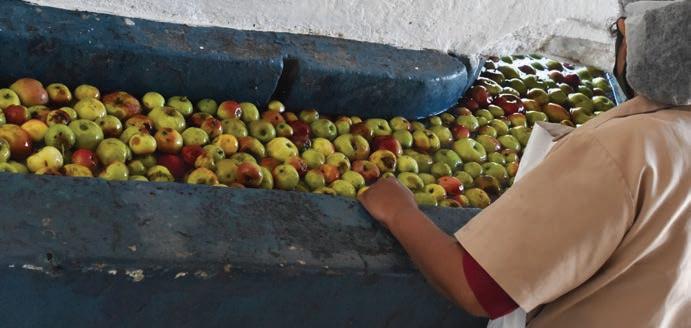
UNA VISITA A COPA DE ORO
A sesenta kilómetros de Huejotzingo, Copa de Oro, en San Pedro Cholula, lleva transformando manzanas en sidra desde 1936. El negocio fue iniciado por Ramón Blanca Amador y sigue siendo propiedad de la familia. Copa de Oro ocupa ahora casi toda una manzana de la ciudad y la producción se ha ampliado hasta un nivel industrial.
Los primeros camiones cargados de manzanas llegan a finales de junio.
“Utilizamos tres tipos de manzanas para nuestra sidra”, dice Alejandra Toxqui Carranza, encargada de las ventas corporativas. “Perón, panochera y ripio”. Estas manzanas también proceden de los pueblos que rodean el Popocatépetl.
Cada día, durante varias semanas, un chorro de agua impulsa una tonelada de manzanas por un conducto de hormigón hasta una trituradora, tras lo cual, como en la Sidra San Francisco, se prensa la pulpa. Sólo que aquí la pulpa se exprime con una enorme prensa hidráulica.
“El líquido se exprime de la pulpa y se recoge en un tanque”, dice Andriana Rojas, asistente de producción. “Desde el tanque, el líquido pasa por otra tubería a tanques de almacenamiento [de acero] que se mantienen a 4º C (39º F)”. Después de dos o tres días, el zumo enfriado se traslada a enormes barricas de roble con una capacidad de entre 32.000 y 70.000 litros, para la etapa de fermentación la cual, aquí, es de diez a quince días.
Al finalizar este paso, el zumo se traslada a otro conjunto de enormes barricas de roble donde, dependiendo del tipo de sidra, se envejece de dos a cinco años y luego se embotella. “Llenamos 30.000 botellas al día”, dice Adriana Rojas, otra asistente de producción.
“Cada año, producimos 300.000 cajas con seis botellas cada una”, dice Jaime Mancilla Salas, jefe de producción. Son 1.800.000 botellas, una cantidad que hace prácticamente imposible que la sidra se produzca a mano.
“Hace quince o veinte años que mecanizamos la producción”, dice Heriberto Morales López, jefe de transformación.
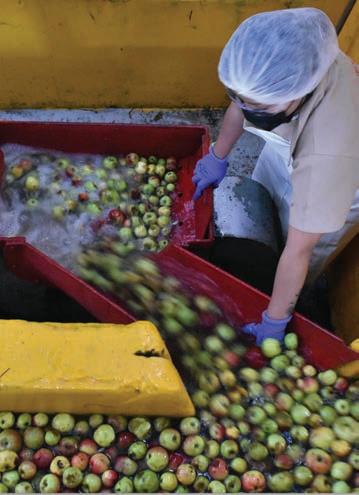
Introducir manzanas en el molinillo es uno de los primeros pasos en la producción de sidra.
VARIEDADES POPULARES
Tanto Sidra San Francisco como Copa de Oro elaboran varios tipos de sidra. La más popular de ambas es el ámbar, una sidra de color ámbar también llamada “champán”. Es una bebida espumosa muy suave y refrescante.
Sidra San Francisco vende varias sidras mezcladas con otros zumos de frutas, como pera, melocotón y fresa. En ambas empresas hay sidras mezcladas con vino tinto. Copa de Oro compra su vino a los viñedos chilenos, pero García y Castillo elaboran el suyo propio a partir de noviembre.
“Elaboramos el nuestro porque tenemos la experiencia”, dice Castillo. “Hemos experimentado y determinado cómo hacer el vino más sabroso”.
Copa de Oro también elabora una cerveza de manzana y una sidra sin alcohol. García se sorprendió cuando le preguntaron si también hacía una versión sin alcohol.
“Para llamarse sidra, debe ser zumo de manzana fermentado”, dice. “La sidra sin alcohol no es sidra”.









